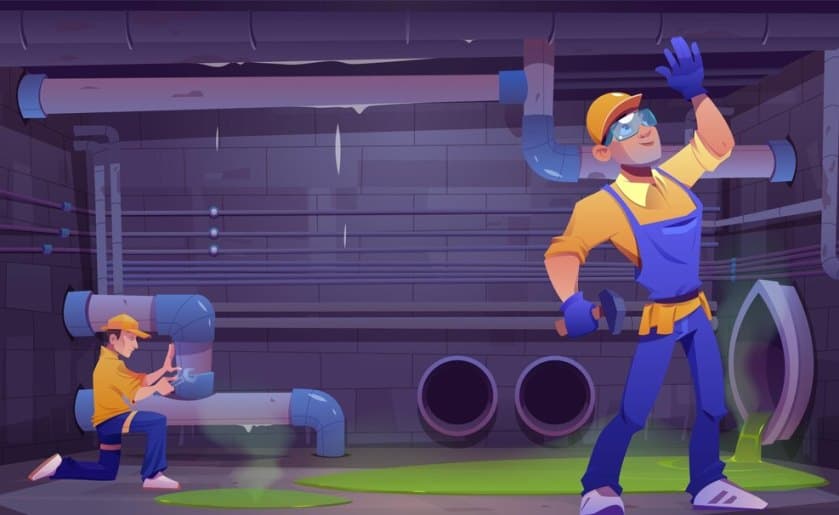Your home’s plumbing system is like the circulatory system of the human body, and the sewer line is the main artery. A faulty sewer line can lead to all sorts of problems. That’s why sewer line replacement is essential to prevent future plumbing issues.
The Telltale Signs
Ever noticed a foul smell wafting through your home? Or maybe you’ve seen multiple drains backing up simultaneously? These are clear indicators that your sewer line might be in trouble. Ignoring these signs can lead to bigger, messier, and costlier problems down the line.
A Personal Tale: The Jones Family Experience
Take the Jones family, for instance. They started noticing a persistent odor in their basement. Initially, they shrugged it off, thinking it was just a minor issue.
But then, their sinks started draining slower than usual, and the stench became unbearable. It turned out their sewer line was cracked and on the verge of collapse. By the time they decided to take action, they had to deal with a flooded basement and a hefty repair bill.
What Causes Sewer Line Problems?
Several factors can lead to sewer line damage. Tree roots are notorious for invading and clogging pipes. Old pipes can corrode and break over time.
Shifts in the ground due to construction or natural causes can also damage your sewer line. And let’s not forget about the common culprits: grease buildup, foreign objects, and flushing inappropriate items down the toilet.
The Process of Sewer Line Replacement
So, what happens when you decide it’s time for a sewer line replacement? First, professionals will conduct a thorough inspection, often using cameras to pinpoint the exact issue.
Once the problem is identified, they’ll decide on the best course of action. There are traditional methods, which involve digging up your yard to replace the pipes.
However, more modern, less invasive techniques like trenchless sewer replacement are also available. These methods involve minimal digging and can often be completed faster.
Trenchless Technology: A Modern Solution
Trenchless sewer line replacement is a game-changer. It uses techniques like pipe bursting or pipe lining to replace old, damaged pipes without extensive excavation.
This method not only saves your landscaping but also reduces labor costs and project time. Plus, the new pipes are usually more durable and resistant to root intrusion and corrosion.
Read Also: Why Is My Septic Tank Full of Water?
Preventing Future Issues
Once your new sewer line is in place, maintaining it becomes crucial. Avoid planting trees or large shrubs near your sewer line. Be mindful of what goes down your drains — no grease, large food particles, or non-flushable items.
Regular inspections and cleanings can also keep your sewer line in good shape. By being proactive, you can avoid the headache and expense of another major repair.
Real-Life Scenario: How It Helped Sarah
Consider Sarah, a homeowner who learned the importance of maintenance the hard way. After replacing her sewer line, she became vigilant about what went down her drains.
She scheduled annual inspections and made sure her family understood the do’s and don’ts of plumbing care. As a result, she hasn’t faced any major plumbing issues since her sewer line replacement.
Financial Implications
Replacing a sewer line might sound expensive, but it’s an investment in your home’s future. The cost of dealing with a major sewage backup, including water damage and potential mold remediation, can far exceed the cost of a proactive replacement. Moreover, a new sewer line can increase your property value, making it a smart long-term financial decision.
Choosing the Right Professionals
When it comes to sewer line replacement, choosing experienced and reliable professionals is crucial. Look for companies with good reviews, proper certifications, and a track record of successful projects. Getting multiple quotes can also help you make an informed decision without overpaying.
An Ounce of Prevention
Remember the old saying, “An ounce of prevention is worth a pound of cure”? This couldn’t be truer when it comes to your sewer line. Taking steps now to replace and maintain it can save you from a world of trouble in the future. Don’t wait for disaster to strike—act now and secure your home’s plumbing health.
Engaging with the Process
Replacing a sewer line might seem daunting, but with the right knowledge and professional help, it’s manageable. Engage with the process, ask questions, and understand what’s happening. It’s your home, after all, and knowing how to protect it is empowering.
Community Experiences
Hearing from others who’ve gone through the process can be reassuring. Many homeowners have shared positive experiences about how sewer line replacement saved them from bigger issues. Their stories highlight the importance of acting quickly and choosing the right professionals.
Final Thoughts
Sewer line replacement might not be the most glamorous home improvement project, but it’s one of the most important. Addressing sewer line issues promptly can save you from future headaches and costly repairs.
By understanding the signs of trouble, choosing the right replacement method, and maintaining your new sewer line, you can ensure your plumbing system remains healthy for years to come.
